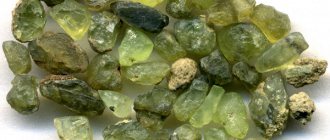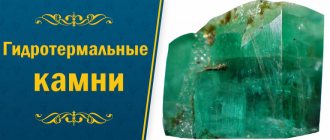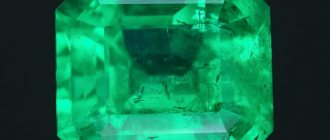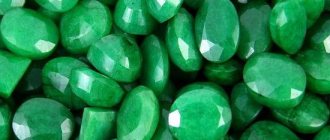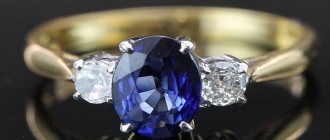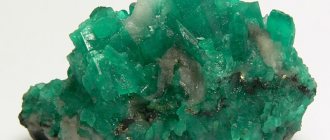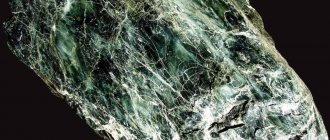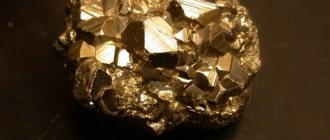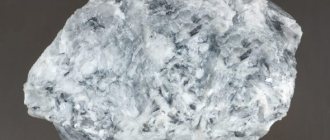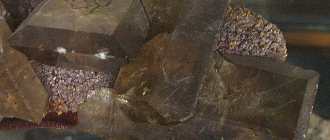| Category | Silicate minerals |
| Title in English | Olivine |
| Formula | (Mg,Fe)2[SiO4] |
| Group | Group of island silicates |
| Color | Pale shades of green |
| Stroke color | White |
| Shine | Glass |
| Transparency | Transparent |
| singonia | Rhombic |
| Hardness | 6,5 — 7 |
| Cleavage | Average |
| Density, g/cm³ | 3,27 — 3,37 |
| Kink | Conchoidal |
| origin of name | The term “olivine” was coined by a German geologist named Abraham Werner. This is how he designated the green inclusions that he noticed in basalts. When this mineral was found, it was decided to give it the name olivine for its beautiful olive color. |
Olivine stone is a member of the family of silicon-containing minerals. By chemical nature, it belongs to quartz containing an admixture of magnesium and iron. Moreover, its properties are absolutely similar to two other stones: chrysolite and peridot. This is due to the fact that in Germany Werner called the transparent green stone “olivine”, and in France it was already known as “peridot”, and in Greece as “peridot”. Today, many other names are known for the stone, but in mineralogy it is generally accepted that the main one is olivine.
Olivine deposits
— Advertising —
The first deposits of olivine were discovered on St. John's Island (Red Sea) in the 4th millennium BC. Today, these deposits are almost completely depleted and exhausted.
The largest modern deposits of olivine were found in the United States, in Arizona and New Mexico. It is also found in countries such as Brazil, Australia, Kenya, Norway, Mexico, Hawaii, Egypt and Russia. Colorless crystals are mined on the island of Sri Lanka. Indian high quality olivine is also known as Kashmir Peridot. Large samples, weighing about 200 carats, are mined in Myanmar.
Other olivine beaches
There are several other green olivine beaches on the planet. One is located on the island of Guam in the western Pacific Ocean, in Micronesia. The island is part of the Mariana archipelago, famous for the fact that in the ocean next to it there is the deepest hole in the earth's crust - the Mariana Trench (11 km).
Here, green olivine, born in the volcano, is adjacent to dazzling white and orange sand from coral chips.
The Galapagos Islands, which belong to Ecuador, boast green beaches. The archipelago is located in the Pacific Ocean, a thousand kilometers from the coast of South America. The islands have active volcanoes that regularly supply olivine.
There is such an exotic beach in Europe, but there are few swimmers there. After all, the olivine beach is located in Norway, and is washed by the waves of the cold North Sea.
History of olivine
The name of the mineral olivine is associated with the similarity of its color to the color of the fruits of olive trees.
It was invented by the French mineralogist Alfred Werner. In those days, the gem was considered a subspecies of chrysolite, but then everything changed, and according to modern ideas, chrysolites are a light variety of olivine. There is a mineral under another name “peridot”. Olivine has been known to mankind relatively recently, but has become widespread in the manufacture of amulets and amulets as a mineral with strong magical properties.
Historical feature of the stone
Very ancient stone
Historians have found that the magical properties of olivine have been used by humans for more than 6,000 years. Beads of this gem were worn by the ancient Egyptians. According to the Bible, chips from it decorated the clothes of the Jewish high priests. Some researchers believe that the legendary emerald through which the Roman Emperor Nero watched the burning capital was olivine. According to legend, peridot (a precious variety of olivine) was the favorite stone of Queen Cleopatra.
In the Middle Ages, European knights brought stone from the Crusades. There was an opinion that it restores and increases male strength.
Olivine crystals decorate the frames of Christian icons. One of the most famous is the icon of Andrei Rublev “Holy Trinity”, kept in Sergiev Posad. This gem adorns the crown of the Russian Empire, along with other precious and semi-precious stones.
Soviet writer A.N. Tolstoy wrote about him in his novel “Engineer Garin’s Hyperboloid”. His book reflected the opinion of geologists of the 20s of the last century about the Olivine Belt, seething at a depth of several tens of kilometers, consisting of molten minerals, among which olivine and gold predominate.
Physicochemical characteristics of olivine
— Advertising —
By chemical nature, olivine is an orthosilicate of magnesium and iron. Its crystals of prismatic or pyramidal shape are rare; granular masses are more common. Olivines are very fragile. Hardness on the Mohs scale 6.5-7. Density 3.27-3.37 g/cm3. The surface of the stone is easy to scratch, and sulfuric acid completely destroys it with the formation of a gelatinous mass.
There are both colorless specimens and black, yellowish-green, olive and bottle green. They have a glassy luster and rhombic structure. There is no cleavage.
The characteristic distinguishing features of olivine are its non-metallic luster, olive-green color, and content in dark rocks of igneous origin. When olivine breaks down, serpentine (serpentine) is formed.
What's actually in the depths of the Earth?
Beneath the earth's crust is the mantle, which surrounds the planet's core. It became isolated during the long evolution of the Earth over 4.5 billion years. Its thickness is about 3000 km. The mantle accounts for 2/3 of the mass of the entire planet, and it consists of heavy minerals, including mainly iron and magnesium. Other common chemical elements include oxygen, silicon, aluminum, calcium, sodium, potassium and their oxides.
The structure of the mantle is divided into 3 layers. The upper one is involved in the movement of lithospheric plates. The middle one has an amorphous structure, consists of plastic matter and is the main source of volcanic magma. The bottom layer is rich in nickel and iron. This structure has not yet been sufficiently studied. It is possible that between it and the core there is another layer, characterized by high temperature and heterogeneity of the substance.
Types of olivine
The most valuable subspecies of olivine, which is widely used in jewelry, is chrysolite. The color of its transparent crystals varies from yellow-green to emerald green and dark olive. There are also pistachio and yellow specimens. It all depends on the content of impurities in each specific sample.
Another variety of olivine is the mineral Hawaiiite, which is a pale green, low-iron olivine that is mined from lava in the Hawaiian Islands.
Silicates of the olivine group also include forsterites, fayalites, knebelites, and tephroites.
Origin of the mineral
The stone was first recorded in 1747. The charming gem received its name thanks to Alfred Werner, who noticed its resemblance to olives. Although the color palette of olivine varies from yellow to black. At first, the stone was classified as a type of chrysolite. This is another natural stone that has a greenish tint. However, over time, scientists came to the conclusion that chrysolite is a type of olivine.
The stone has long been considered by connoisseurs of expensive jewelry. It looks no worse than an expensive emerald. In addition, esotericists considered quite powerful energy in this gem. Therefore, many women and men use the mineral as a personal talisman.
The magical properties of olivine
Olivine is the patron saint of both strong-willed and weak people.
It protects from unpleasant situations and leads its owner onto the path of good luck and success, while showing him the right, correct path. Since ancient times, the gem has been considered a source of secret knowledge, thanks to which its owner can successfully implement all his ideas, even those that had previously led to failure.
For people who desire to gain fame and fortune, olivine will also be a good helper. Along with fame and money, the stone will also give the owner morality and wisdom, the ability to achieve what he wants by following an honest path.
Olivine also helps in family problems. It strengthens family ties, eliminates conflicts, quarrels, and protects the home from the envy and anger of others. It is also believed that it prevents fires.
Olivine saves those who are inclined to take risks without thinking about their actions for a long time. At the same time, a person begins to avoid rash actions and gains wisdom.
Pallas iron
In 1749, the blacksmith and ore miner Yakov Medvedev became interested in an unusual iron nugget interspersed with green stone. He found this block of more than 40 pounds not far from a mining village, on the slopes of the Lesser Altai (now Krasnoyarsk Territory, Novoselovsky District, territory of the Komsky Village Council).
Medvedev dragged the nugget into the yard of the forge, and little by little he beat off pieces for crafts, marveling at the fact that the iron did not rust at all in the rains.
23 years later, the German naturalist and traveler Peter Pallas, academician of the St. Petersburg Imperial Academy of Sciences, visited these lands with a scientific expedition. Having examined the unique boulder, the scientist identified it as an alloy of olivine stone and native iron, and ordered it to be sent to the capital.
By the way, the Khakass, the indigenous inhabitants of these places, told Pallas that this boulder was a sacred stone, a gift from the gods, sent from heaven. But the German scientist considered such stories to be fiction.
This block, called Pallas's iron , was reported by Peter Pallas in publications of European scientific communities. Samples broken off from this strange olivine-iron formation were sent to the centers of science - Paris, Berlin, Vienna, London.
Medicinal properties of olivine
The range of healing properties of olivine is very wide and includes the following areas:
- normalization of the nervous system;
- treatment of heart and vascular diseases;
- gynecological diseases, as well as childbirth - to relieve pain and ease contractions;
- in case of metabolic disorders to stabilize it;
- for healing wounds quickly;
- to enhance male potency;
- for headaches and migraines;
- to normalize sleep and get rid of nightmares;
- after strokes for faster recovery;
- to stabilize the condition of patients with multiple sclerosis;
- to normalize a person’s psychological state, reduce anger, aggression, jealousy, indignation, hysteria.
Olivine is very popular in the treatment of vision. To do this, they look at the mineral for a long time and their vision becomes better.
It is recommended for newborns to hang an olivine amulet around their neck to protect them from illness and negative energy.
In folk medicine, it is advised to place the mineral next to the diseased organ for a while.
Olivine, which is used for medicinal purposes, is important to regularly cleanse of the negative energy that it absorbs along with diseases.
Mystical abilities
Psychics claim that olivine has powerful magical energy. The stone helps its owner achieve their goals:
- increases self-esteem in timid and shy people, gives them confidence;
- makes overly emotional people more reasonable and calm, minimizing manifestations of aggression;
- enhances a person’s natural charm, thereby helping him to win over his interlocutors and business partners when concluding deals;
- Olivine is used to create amulets designed to protect their bearers from the evil eye, damage, unreliable unscrupulous partners, and also to attract money.
People who decide to turn to the magical help of an amulet with olivine, when choosing a talisman, should focus not on the size of the mineral contained in the jewelry, but on its purity and transparency.
Applications of olivine
In jewelry, olivine is known as peridot or peridot and is very popular. This is due to the exquisite noble shine, golden-green color of the stone, and its ability to refract light. Thanks to all these qualities, jewelry with olivines is very, very beautiful. They are used to make earrings, brooches, necklaces, rings, and hairpins. Unfortunately, due to low wear resistance, jewelry with olivine is rare and is quite expensive.
Olivine colors
The color of olivine is determined by the concentration of impurities in it, namely the content of nickel and chromium. In addition to all shades of green, there are black and colorless samples. And the most valuable are considered to be olivines with uneven coloring, in which the golden-green color smoothly flows into greenish-brown or turquoise.
Why did the hypothesis become so popular?
The idea of world domination and easy enrichment has existed at all times. Tolstoy's novel was a sign of the era in which the writer lived. At the beginning of the 20th century, a kind of “explosion” of technical thought occurred, and new types of weapons of mass destruction were developed. Tolstoy reworked the chapters of the novel several times, and the last, fourth part, was finally completed in 1939, before the outbreak of World War II.
An interesting fact is that he was inspired to create this work by the Shukhov Tower, better known as the Shabolovskaya Television Tower. It was erected in 1920-1922. and during its construction, for the first time in the world, hyperboloid metal structures were used. The grandiose creation of human hands delighted contemporaries and at the same time instilled fear of the possible negative role of technical discoveries.
How to care for olivine
Olivine is protected from mechanical stress and stored separately from all other types of stones, in tightly closed boxes, wrapped in soft cloth. To clean products with this gem, you can use warm soapy water, after which they are rinsed under running cool water and thoroughly polished with a soft cloth.
How much does space pallasite cost?
The question is not at all idle. A pebble lying on the ground waiting for an attentive passerby can be more expensive than a gold bar.
Meteorites are coveted exhibits in collectors' collections. There is a particularly high demand for rare pallasites, although their cost is truly astronomical and is accessible to very few collectors - up to $40,000 per kilogram.
The thin polished sections of pallasite are especially beautiful. The bluish metal tightly frames the yellow-green crystalline formations of olivine. Such sections are reminiscent of artistic stained glass windows of avant-garde design.
However, there are meteorites that are more expensive. Fragments of completely inconspicuous-looking rocks that flew to Earth from Mars or the Moon can cost up to $10,000. Only not per kilogram, but per gram (5 carats). This cost is comparable to a good five-carat gem.
Olivine and the zodiac sign
Olivine is the patron saint of representatives of the three zodiac signs.
He helps Virgo in acquiring knowledge and wisdom, gives patience, and teaches him to enjoy freedom. It somewhat reduces the natural demandingness and conservatism of this sign, and adds the necessary degree of recklessness. For Pisces, olivine brings confidence and eliminates minor troubles. Teaches endurance and the ability to endure stress.
The gem also helps Leos, as it successfully restrains their internal aggression. At the same time, Leos begin to resolve conflict situations with others peacefully, become softer and more sensitive, while gaining friends and supporters, as well as the sympathy of others.
